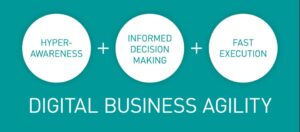
Overture: Develop agility for digital business transformation
This is the second in a 4-part series of articles about digital disruption by the Global Center for Digital Business Transformation (DBT Center), a joint initiative of IMD business school and Cisco. The series explores how digital disruption is altering traditional competitive dynamics in virtually every industry – and what you can do to ensure your company thrives.
The digital vortex: you’re in it
As we wrote in the first article of this series , digital disruption can be seen as a Vortex – something that exerts a rotational force that draws everything into its center. Our research has shown that in just the last two years, the speed and impact of digital disruption has increased dramatically in virtually every sector – 49% of companies we surveyed in 2017 now say that they are currently being impacted, compared to just 15% in 2015.
You could wait for digital disruption to hit you and just hope for the best, as many have done. Or you could proactively disrupt yourself and make digitization the critical opportunity it can be. At the DBT Center, our research and experience has helped us develop a framework for mapping and implementing your best course of action, one we call the Digital Orchestra. The analogy likens the different areas of operation that a company needs to address to conduct their transformation. Yet before you can make beautiful “music”, your orchestra will need to tune instruments and ears, and practice to be able to play flawlessly every time. Because your business is playing in a Vortex and not a swank concert hall, you’ll need to do this no matter the conditions. Get ready by honing your digital business agility.

Developing digital business agility
To grow in the Digital Vortex, companies must generate significant returns through new market opportunities. Unfortunately, most companies lack the wherewithal to do so consistently. But when you’ve got digital business agility, you can respond quickly and effectively to emerging threats – and get there first to seize new market opportunities. There are three main pillars: hyperawareness, informed decision-making, and fast execution. Notice that none of these requires technology, per se? Rather they are founding skills to survive – and thrive – in the Vortex.
1. HYPERAWARENESS
Hyperawareness keeps you from getting thrown by the sudden arrival of new competitive threats (traditional, non-traditional, even unintentional side-effects). It also means being aware of your own vulnerabilities – because you have some, and that’s ok – so you can adjust your business models to mitigate these.
How can you become hyperaware of your strengths and vulnerabilities; the true value of your services/products to your customers; threats to your market position; and models you could use to disrupt?
2. INFORMED DECISION MAKING
The businessperson who achieves astounding success going solely by “gut feeling” is not much better off than a dodo bird in the Digital Vortex. “Gut feeling” has a lot to do with past experience, but in the Vortex, what happened yesterday can have little to do with what happens today. Informed decision-making is vital to setting the best strategies in a given situation. Fortunately, the digital age provides tools, such as Big Data and data analytics, to complement human judgement for better decisions. Along with insights from data analytics, you should promote diversity of perspective and corporate inclusion for successful informed decision-making.
What resources does your company have to help inform decisions? What other ones could be implemented?
3. FAST EXECUTION
One trait that allows start-ups to excel is that they are able to execute rapidly. They are unencumbered by organizational complexity and unafraid to invest resources in the unknown (unlike traditional firms). Start-ups out-execute incumbents in areas such as time to market, experimentation, and risk-taking – all core capabilities in the Vortex. Savvy incumbents must incorporate these strategies through venture partnerships, sponsored hackathons and incubator labs.
How fast and effectively can your company carry out its plans? How could you execute faster?
Preparing your Digital Orchestra
You’ve limbered up for agility. It’s time to bring together the instruments and the sections together to establish a Digital Orchestra. Stay tuned for next week’s article for our tips on creating an orchestra to play harmoniously for success in the midst of the Digital Vortex.
Click here to view the next article in this series, Crescendo: Build your Digital Orchestra.
Research Information & Knowledge Hub for additional information on IMD publications
The case study introduces an original way of exploring the many questions and concerns around AI adoption in business. Based on a true story, it discusses the dilemma of AI implementation through Joe, the CIO of ParcelFlow. Joe is getting ready to...
This technical note presents a comprehensive framework for maximizing leadership impact through a Leader Amplification System (LAS). The note begins by defining one's unique value-creating purpose, then goes on to explore how leaders can extend th...
This case study explores AstraPay’s journey to become a significant player, despite its latecomer status, in Indonesia’s burgeoning digital payments landscape. Launched in 2018, AstraPay had grown to serve over one million customers, but it faced ...
Research Information & Knowledge Hub for additional information on IMD publications
Research Information & Knowledge Hub for additional information on IMD publications
Research Information & Knowledge Hub for additional information on IMD publications
Research Information & Knowledge Hub for additional information on IMD publications
Research Information & Knowledge Hub for additional information on IMD publications
Research Information & Knowledge Hub for additional information on IMD publications
Research Information & Knowledge Hub for additional information on IMD publications
Research Information & Knowledge Hub for additional information on IMD publications
Research Information & Knowledge Hub for additional information on IMD publications
Case reference: IMD-2650 ©2025
Research Information & Knowledge Hub for additional information on IMD publications








